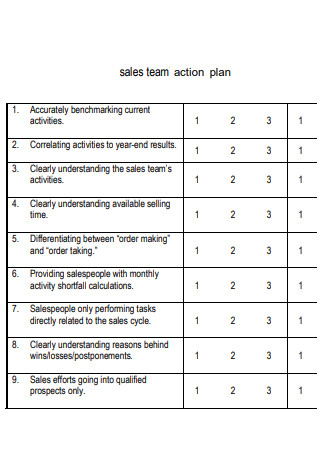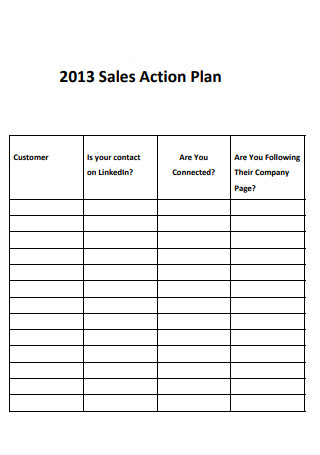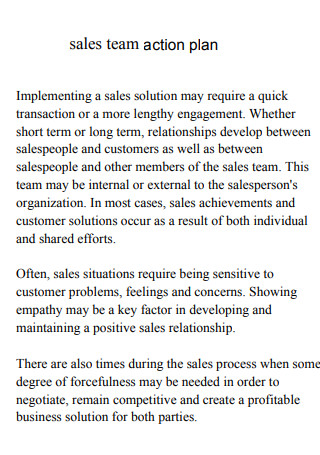3+ SAMPLE Sales Team Action Plan
FREE Sales Team Action Plan s to Download
3+ SAMPLE Sales Team Action Plan
What is a Sales Team Action Plan?
Basic Components of a Sales Team Action Plan
How to Write a Sales Team Action Plan
FAQs
What are the steps of creating a sales plan
What are the responsibilities of the sales team
How to keep a sales team focused
What are the fundamental steps of the sales process
How to motivate your sales team
What are the 7 P’s of sales?
What are the core sales strategies?
What are the essential methods to increase sales?
What is a Sales Team Action Plan?
A sales team action plan is a clear and effective roadmap or comprehensive document which contains specific sales goals, targets, target audience and segmentation, sales strategies and methodologies, and a sales execution plan that guide the different kinds of sales and marketing professionals to fulfill their goals depending on their roles and responsibilities in their team. It is a beneficial management tool with the purpose of facilitating strategic planning in the sales team to attain further development and performance success.
A 2022 research report published that optimistic sales professionals outperform pessimists by 57%. Sales representatives and other sales professionals need to be successful when they earn the trust of their prospective buyers. Each member of the sales team should have an access to various sale analytics tools and logical benchmarks to evaluate their progress. With the use of an action plan, all kinds of sales and marketing professionals such as sales associates, sales marketing officers, and others can meet their sales goals and objectives and improve the overall performance of their team.
Benefits of a Sales Team Action Plan
Planning should be your priority in every aspect of your sales management and development work. When managing your sales team and sales performance system, it is essential to craft a well-structured sales team action plan. Remember to establish challenging expectations, measure the critical success factors, track gains and gaps, review your quarterly data, and use every opportunity to reinforce gains specifically.
1. Encourages Logical Analysis and Thinking
Using an effective sales team action plan helps the sales representatives, sales associates, and sales managers to encourage them to have logical analysis and thinking. You need to think carefully about what has happened before, what certain actions have brought about full success or partial success, and what specific actions were irrelevant and have not helped at all. Thus, it is an important roadmap to assist you in contemplating your actions and analyzing them intently so that you are able to develop proper decisions in sales team planning.
2. Organizes the Sales Team
A well-designed sales team action plan is an integral part of developing and organizing the sales team. It assists the sales manager to capture accurate data, be responsible for making fundamental decisions, to consider the appropriate positions for the team members, and to accomplish major objectives through the efforts of the sales team. The head of the sales team uses the action plan to hold sales team personnel accountable for what they do. Also, it helps them to become open-minded and flexible.
3. Resolves Negative Issues and Motivates Turnaround Performance
If you are currently developing a sales team action plan, it will guide you in resolving negative issues such as work ethic, not following policy, plateaued performance, conflict with others, poor attitude, and many others. There are times that some sales representatives are failing often for no apparent reason due to a drop-off or slump in sales performance or lack of improvement. An action plan is made to help those individuals awaken a new attitude at the last chance to reach success.
4. Sets the Stage for Long-Term Development and Direction
Writing a sales team action plan can lead to the long-term development and direction of the business, organization, and/or professional. Include positive counsel in the action plan to give recognition and reinforce performance to your sales team members. Allow the sales team members to learn about each ambition, motivation, and personal life, as well as fortify relationships and trust.
Basic Components of a Sales Team Action Plan
Construct a well-written and comprehensive sales team action plan when you become familiar with the essential aspects of this plan. A sales team action plan has different kinds of components. Include the following elements for you to create a professional document:
How to Write a Sales Team Action Plan
Creating the blueprint of the essential sales and marketing activities, strategies, assessments, and other aspects of your sales team is very important to fully achieve your targets. Some of the things you need to do are assess your past and current situation, determine where skill gaps appear, and develop an updated sales team action plan. Doing this will guide your team and renew their motivation in reaching your sales target.
-
1. Establish Sales Goals and Objectives
What are your specific goals, objectives and vision for your sales? Take your time to know what exactly you want to fulfill in your sales team action plan. Think about your revenue goals and how your team will break down your sales targets into quarterly and monthly quotas. Your sales goals must be specific, measurable, attainable, relevant and time-bound. For example, your sales goal for the next month or quarter is to increase revenue by 20% or to boost customer retention by 10%.
-
2. Describe the Company and Sales Team Structure
Why does your company exist? Describe the origin of the company and its position in the market. Tell your readers about your sales team and their expertise. Explain their designated responsibilities and tasks in your team. Some examples of sales roles and responsibilities are sales strategy responsibility, market segment and channel responsibility, sales process responsibility, and management responsibility.
-
3. Define Target Audience and Sales Strategies
Include details about the major characteristics of your target market. Where does your company want to focus on your target market? Then, outline the strategies and methods on how you will prioritize sales activities. What sales methods do you want to execute? Map each stage of your sales process and define each stage. For instance, you need to detect a problem, understand your brand or product, price your products and services properly, know your customer, align with the needs and preferences of your customers, and build a strong relationship.
-
4. Create a Sales Execution Plan
Prepare a sales execution plan to let your sales team know how you will act on the data. Outline the different stages, implementable actions, methodologies, results, and goals of your sales process. This plan also indicates the time when specific sales management activities and projects are implemented. After that, inform your sales indicators and KPIs so that you can evaluate your sales team’s performance..
-
5. Proofread and Prepare the Overall Sales Plan
Review your overall sales team action plan and make sure to fully add all the critical points in your document. It must demonstrate the connection between the sales goals, objectives, resources, strategies, and methods, activities used for executing the objectives, and the evaluation of the people involved in the sales action plan. If you overlook some sections that need more points, edit and revise the document right away.
FAQs
What are the steps of creating a sales plan?
The steps of creating a sales plan are analyzing the current state of sales, identifying the objectives of the plan, determining the challenges and other issues to success, defining the assets and strengths, outlining an effective sales process, recognizing needs and wants, and implementing, monitoring and adjusting the plan.
What are the responsibilities of the sales team?
The responsibilities of the sales team are developing sales plans, prospecting, researching, managing sales issues, building customer relationships, and training and onboarding new sales team members.
How to keep a sales team focused?
It is important to provide sales consumable data, offer your head managers streamlined processes, create structured feedback, and give them the key steps on what they need to do.
What are the fundamental steps of the sales process?
The fundamental steps of the sales process are the prospecting stage, qualifying stage, initial meeting and needs discovery stage, needs analysis, product or service demo presentation, proposal or quotation presentation, influencer approval, and key decision maker or committee approval.
How to motivate your sales team?
Build trust with the people on your team, ask them how they prefer to be managed, understand their personal and professional goals, ensure that they are covering the basics, establish your daily, weekly, and monthly goals, and investigate where the problem lies.
The 7 P’s of sales are product, price, place, promotion, packaging, positioning, and people.
What are the 7 P’s of sales?
The core sales strategies are identifying your buyer, telling a story, targeting a niche market, selling your brand or product, and focusing on internal growth.
What are the core sales strategies?
The essential methods to increase sales are increasing the number of customers, the average transaction size, and the frequency of transactions per customer, and especially, raising the costs of your products or services.
Some companies and organizations encourage their sales marketing teams to carry out an action plan aimed at fulfilling key sales and marketing objectives. Writing a clear and well-coordinated sales team action plan will undoubtedly help you and many other sales managers, sales associates, and other sales marketing professionals to keep track of your sales processes and optimize your sales strategies and methodologies. Highlight the fundamental tools and talents you need to apply and cultivate, as well as cover the functions of the entire sales team. Plus, we have included several sales team action plan samples that you can easily customize and download for your business.
What are the essential methods to increase sales?




